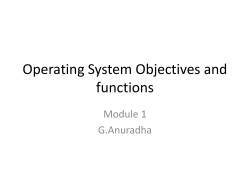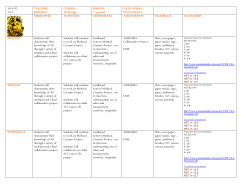
1.What is Microprocessor ?
1.What is Microprocessor ? It is a program controlled semiconductor device (IC}, which fetches, decode and executes instructions. 2. What are the basic units of a microprocessor ? The basic units or blocks of a microprocessor are ALU, an array of registers and control unit. 3. What is assembly language? The language in which the mnemonics (short -hand form of instructions) are used to write a program is called assembly language. The manufacturers of microprocessor give the mnemonics. 4. What is the drawback in machine language and assembly language, programs? The machine language and assembly language programs are machine dependent. The programs developed using these languages for a particular machine cannot be directly run on another machine . 5. Why data bus is bi-directional? The microprocessor has to fetch (read) the data from memory or input device for processing and after processing, it has to store (write) the data to memory or output device. Hence the data bus is bidirectional. 6. Why address bus is unidirectional? The address is an identification number used by the microprocessor to identify or access a memory location or I / O device. It is an output signal from the processor. Hence the address bus is unidirectional. 7. What are the modes in which 8086 can operate? The 8086 can operate in two modes and they are minimum (or uniprocessor) mode and maximum ( or multiprocessor) mode. 8. Write the flags of 8086. The 8086 has nine flags and they are 1. Carry Flag (CF) 6. Overflow Flag (OF) 2. Parity Flag (PF) 7. Trace Flag (TF) 3. Auxiliary carry Flag (AF) 8. Interrupt Flag (IF) 4. Zero Flag (ZF) 9. Direction Flag (DF) 5. Sign Flag (SF) 9. What are the interrupts of 8086? The interrupts of 8085 are INTR and NMI. The INTR is general maskable interrupt and NMI is nonmaskable interrupt. 10. Write the special functions carried by the general purpose registers of 8086. The special functions carried by the registers of 8086 are the following. Register Special function 1. AX 16-bit Accumulator 2. AL 8-bit Accumulator 3. BX Base Register 4. CX Count Register 5. DX .Data Register 11. What is pipelined architecture? In pipelined architecture the processor will have number of functional units and the execution time of functional units are overlapped. Each functional unit works independently most of the time. 12. What is processor cycle (Machine cycle)? The processor cycle or machine cycle is the basic operation performed by the processor. To execute an instruction, the processor will run one or more machine cycles in a particular order. 13. What is Instruction cycle? The sequence of operations that a processor has to carry out while executing the instruction is called Instruction cycle. Each instruction cycle of a processor indium consists of a number of machine cycles. 14. What is fetch and execute cycle? In general, the instruction cycle of an instruction can be divided into fetch and execute cycles. The fetch cycle is executed to fetch the opcode from memory. The execute cycle is executed to decode the instruction and to perform the work instructed by the instruction. 15. What is the need for timing diagram? The timing diagram provides information regarding the status of various signals, when a machine cycle is executed. The knowledge of timing diagram is essential for system designer to select matched peripheral devices like memories, latches, ports, etc., to form a microprocessor system. 16. What is opcode fetch cycle? The opcode fetch cycle is a machine cycle executed to fetch the opcode of an instruction stored in memory. Every instruction starts with opcode fetch machine cycle. 17. Where is the READY signal used? READY is an input signal to the processor, used by the memory or I/O devices to get extra time for data transfer or to introduce wait states in the bus cycles. 18. What is HOLD and HLDA and how it is used? Hold and hold acknowledge signals are used for the Direct Memory Access (DMA) type of data transfer. The DMA controller place a high on HOLD pin in order to take control of the system bus. The HOLD request is acknowledged by the 8085 by driving all its tristated pins to high impedance state and asserting HLDA signal high. 19. How the vector address is generated for the INTR interrupt of 8085? For the interrupt INTR, the interrupting device has to place either RST opcode or CALL opcode followed by l6-bit address. I~RST opcode is placed then the corresponding vector address is generated by the processor. In case of CALL opcode the given l6-bit address will be the vector address. 20. When the 8085 processor checks for an interrupt? In the second T -state of the last machine cycle of every instruction, the 8085 processor checks whether an interrupt request is made or not. 21. What is interrupt acknowledge cycle? The interrupt acknowledge cycle is a machine cycle executed by 8085 processor to get the address of the interrupt service routine in-order to service the interrupt device. 22. How the interrupts are affected by system reset? Whenever the processor or system is resetted , all the interrupts except TRAP are disabled. fu order to enable the interrupts, El instruction has to be executed after a reset. 23. What is Software interrupts? The Software interrupts are program instructions. These instructions are inserted at desired locations in a program. While running a program, if software interrupt instruction is encountered then the processor executes an interrupt service routine. 24. What is Hardware interrupt? If an interrupt is initiated in a processor by an appropriate signal at the interrupt pin, then the interrupt is called Hardware interrupt. 25. What is the difference between Hardware and Software interrupt? The Software interrupt is initiated by the main program, but the Hardware interrupt is initiated by an external device. In 8085, the Software interrupt cannot be disabled or masked but the Hardware interrupt except TRAP can be disabled or masked. 26. What is Vectored and Non- Vectored interrupt? When an interrupt is accepted, if the processor control branches to a specific address defined by the manufacturer then the interrupt is called vectored interrupt. In Non-vectored interrupt there is no specific address for storing the interrupt service routine. Hence the interrupted device should give the address of the interrupt service routine. 27. List the Software and Hardware interrupts of 8085? Software interrupts: RST 0, RSTl, RST 2, RST 3, RST 4, RST 5, RST 6 and RST 7. Hardware interrupts: TRAP, RST 7.5, RST 6.5, RST 5.5 and INTR. 28. What is TRAP? The TRAP is non-maskable interrupt of8085. It is not disabled by processor reset or after reorganization of interrupt.
© Copyright 2025





















